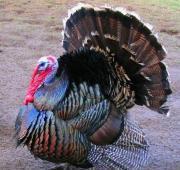 The turkey is a large bird that is closely related to other game birds such as pheasants, chickens and quails. The turkey has become famous across the western world as being a special meal on large family occasions including Christmas and Thanksgiving.
The turkey is a large bird that is closely related to other game birds such as pheasants, chickens and quails. The turkey has become famous across the western world as being a special meal on large family occasions including Christmas and Thanksgiving.  Despite their large size, turkeys are surprisingly adept fliers and can be seen flying beneath the forest canopy looking for somewhere to perch. Although turkeys do nest in the trees, they are most commonly found in open forests, woodlands and grasslands.
Despite their large size, turkeys are surprisingly adept fliers and can be seen flying beneath the forest canopy looking for somewhere to perch. Although turkeys do nest in the trees, they are most commonly found in open forests, woodlands and grasslands.


The ocellated turkey is a more elegant looking bird and, although closely related to the wild turkey, the ocellated turkey is very similar in appearance to a female peacock. The ocellated turkey has a narrow body and long legs, and the males have featherless necks and heads which can be red or blue in colour and are often more subtle than the those of the male wild turkeys.
The turkey is an omnivorous animal meaning that it eats both plants and plant matter, and other animals. The turkey primarily eats nuts, seeds, fruits, berries and insects which is often finds whilst scratching around on the forest floor. The turkey also eats small reptiles, amphibians and even rodents should it get the chance.
Despite its large size, both species of turkey have a number of predators within their natural environment. Foxes, snakes, raccoons, wildcats and humans are the most common predators of the turkey.
During the mating season, male turkeys make gobbling noises in order to try and attract a female turkey to mate with. The female turkey finds somewhere safe to make her nest and lays between 6 and 12 eggs which hatch after an incubation period of about a month.
Today, the turkey is one of the most popular meats to eat on festive occasions and is farmed in large numbers across the western world. It is thought that over 250 million turkeys are farmed in the United States every year!

